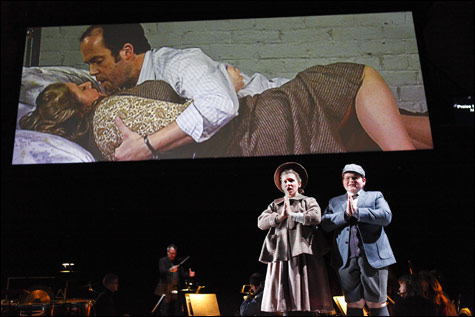BLO's The Turn of the S crew, Levine's Carter and Simon Boccanegra, Teatro Lirico, the Berlin Philharmonic Wind Quintet, and more
By LLOYD SCHWARTZ | February 9, 2010

THE TURN OF THE SCREW Flora and Miles say their prayers while, on the video screen, Quint and Miss Jessel act out another kind of bedtime story. |
Boston Lyric Opera's inaugural Opera Annex production of Benjamin Britten's The Turn of the Screw, at the old Castle on Columbus Avenue (a late 19th-century armory), was so good in so many ways, it's painful that one bad idea just about sank it. BLO has a history of ignoring the "less is more" rule. Its previous version of the Britten, in 1987, also had a terrible idea: two casts on stage simultaneously, both in costume — one singing, one using sign language (before supertitles made signing for the hearing-impaired superfluous). At the climax, the two women playing the Governess (who's in despair that her young charges have been possessed by a couple of predatory ghosts) stood right next to each other as one sang and the other signed the words "I am alone!" It's surely the only production in which this line ever got a laugh.
This time, there was another double image: singers both on the stage and projected overhead onto two gigantic video screens fed live from the cellar of the Castle. We saw characters sleeping, making out, playing games — literal, static, heavy-handed, clumsy images that yanked the eye away from the proceedings on stage. Director Sam Helfrich (and video artist Leah Gelpe) seemed to forget that Britten based his opera on Henry James, master of the unspoken innuendo. A shame Helfrich didn't trust his subtle and convincing cast: Emily Pulley as the Governess; Vale Rideout as the seductive Peter Quint; Rebecca Nash as his betrayed collaborator, Miss Jessel; Joyce Castle as Mrs. Grose, the uncomprehending servant. Andrew Lieberman's elegant stage design took imaginative advantage of the spooky venue. A playing area of black-and-white parquet to our right, with a simple desk, extended to our left into a long narrow runway that also created a kind of shallow pit for the orchestra.
A director who's had both successes (Handel's Agrippina, Kurt Weill's Mahagonny) and failures (Mozart's Don Giovanni, Carl Maria von Weber's Der Freischütz), Helfrich offered some nice touches. Instead of having the young Miles mime playing the piano, he had him slip into the orchestra pit behind Damien Francœur-Krzyzek and imitate the pianist's finger movements in the air. But Helfrich could have used the videos to illuminate the opera. "I am all things strange and bold," sings Quint, the dead valet with whom young Miles is still having some sort of sinister relationship. Whether Quint is a child abuser or the manifestation of every child's dark fantasy world is precisely the ambiguity Britten and librettist Myfanwy Piper wanted. Wouldn't an alluring, sexually charged vision of what Quint imagines have been a more exciting projection than a close-up of the Governess in bed, acting upset? And aren't a toy car and a small beachball odd choices for phallic symbols?
 Related
Related:
Ye gods!, Review: Against Me! at Port City Music Hall, Jonathan McPhee and The Longwood Symphony Orchestra, More 
- Ye gods!
Much beautiful music turns up in the 18th-century operatic form that’s probably most alien to a modern audience.
- Review: Against Me! at Port City Music Hall
My sophomore year in college I met a girl named Erin. She had bleached blonde spiky hair, tattoos, and a lip ring. She had spent the previous year hitchhiking around the country and while I was attending outdoor arena concerts, she was at basement punk shows.
- Jonathan McPhee and The Longwood Symphony Orchestra
Jonathan McPhee and The Longwood Symphony Orchestra at Jordan Hall on May 1, 2010
- Blythe spirit
Leaving the Cutler Majestic after the opening night of Opera Boston’s latest Offenbach, La Grande-Duchesse de Gérolstein , you could see the smiling faces of an audience that had had a good time.
- The Big Hurt: A big country lesbian pissing match
Reports began to surface recently that a major country star was set to come out of the closet in People magazine. I had high hopes for Chris Gaines, but no such luck.
- Covering Lacy
For Josh Sinton, Steve Lacy stood out almost from the beginning.
- Photos: Band of Horses at the Ames Hotel
Band of Horses, live at WFNX Ames Hotel Session
- Everyone Everywhere | Everyone Everywhere
Remember when emo wasn’t just some watered-down pop-punk version of goth? No? Well . . . it wasn’t.
- Photos: Pearl Jam live at the TD Garden
Pearl Jam's Boston stop on their 2010 tour
- Mr. Incongeniality
The night before this interview, Bomshot pulled what might go down as the most boneheaded stunt in Boston hip-hop history when, in the middle of a crowded Slaine and Ill Bill show at Harpers Ferry, he attempted to cheap-shot the former from behind.
- Summer treats
From Andean to zydeco, pick your flavor and there's a summer music festival ready to serve it up.
- Less

 Topics
Topics:
Classical
, Richard Goode, Arts, Don Giovanni, More  , Richard Goode, Arts, Don Giovanni, Benjamin Britten, Henry James, Peter Quint, Claude Debussy, Sam Helfrich, William Powers, Simon Rattle, Less
, Richard Goode, Arts, Don Giovanni, Benjamin Britten, Henry James, Peter Quint, Claude Debussy, Sam Helfrich, William Powers, Simon Rattle, Less 